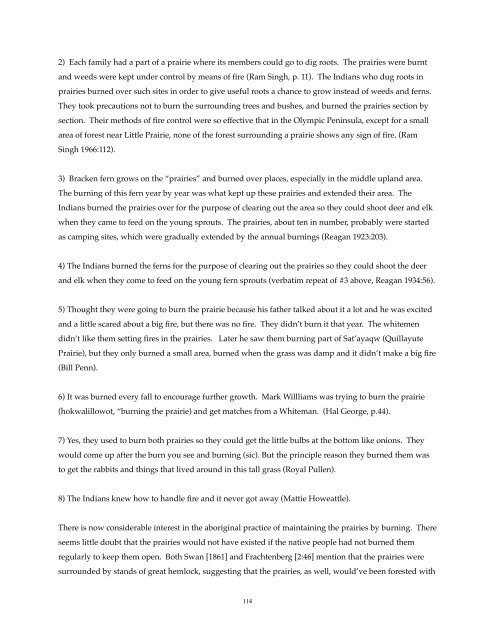The Ozette Prairies of Olympic National Park - Natural Resources ...
The Ozette Prairies of Olympic National Park - Natural Resources ...
The Ozette Prairies of Olympic National Park - Natural Resources ...
Create successful ePaper yourself
Turn your PDF publications into a flip-book with our unique Google optimized e-Paper software.
2) Each family had a part <strong>of</strong> a prairie where its members could go to dig roots. <strong>The</strong> prairies were burnt<br />
and weeds were kept under control by means <strong>of</strong> fire (Ram Singh, p. 11). <strong>The</strong> Indians who dug roots in<br />
prairies burned over such sites in order to give useful roots a chance to grow instead <strong>of</strong> weeds and ferns.<br />
<strong>The</strong>y took precautions not to burn the surrounding trees and bushes, and burned the prairies section by<br />
section. <strong>The</strong>ir methods <strong>of</strong> fire control were so effective that in the <strong>Olympic</strong> Peninsula, except for a small<br />
area <strong>of</strong> forest near Little Prairie, none <strong>of</strong> the forest surrounding a prairie shows any sign <strong>of</strong> fire. (Ram<br />
Singh 1966:112).<br />
3) Bracken fern grows on the “prairies” and burned over places, especially in the middle upland area.<br />
<strong>The</strong> burning <strong>of</strong> this fern year by year was what kept up these prairies and extended their area. <strong>The</strong><br />
Indians burned the prairies over for the purpose <strong>of</strong> clearing out the area so they could shoot deer and elk<br />
when they came to feed on the young sprouts. <strong>The</strong> prairies, about ten in number, probably were started<br />
as camping sites, which were gradually extended by the annual burnings (Reagan 1923:203).<br />
4) <strong>The</strong> Indians burned the ferns for the purpose <strong>of</strong> clearing out the prairies so they could shoot the deer<br />
and elk when they come to feed on the young fern sprouts (verbatim repeat <strong>of</strong> #3 above, Reagan 1934:56).<br />
5) Thought they were going to burn the prairie because his father talked about it a lot and he was excited<br />
and a little scared about a big fire, but there was no fire. <strong>The</strong>y didn’t burn it that year. <strong>The</strong> whitemen<br />
didn’t like them setting fires in the prairies. Later he saw them burning part <strong>of</strong> Sat’ayaqw (Quillayute<br />
Prairie), but they only burned a small area, burned when the grass was damp and it didn’t make a big fire<br />
(Bill Penn).<br />
6) It was burned every fall to encourage further growth. Mark Willliams was trying to burn the prairie<br />
(hokwalillowot, “burning the prairie) and get matches from a Whiteman. (Hal George, p.44).<br />
7) Yes, they used to burn both prairies so they could get the little bulbs at the bottom like onions. <strong>The</strong>y<br />
would come up after the burn you see and burning (sic). But the principle reason they burned them was<br />
to get the rabbits and things that lived around in this tall grass (Royal Pullen).<br />
8) <strong>The</strong> Indians knew how to handle fire and it never got away (Mattie Howeattle).<br />
<strong>The</strong>re is now considerable interest in the aboriginal practice <strong>of</strong> maintaining the prairies by burning. <strong>The</strong>re<br />
seems little doubt that the prairies would not have existed if the native people had not burned them<br />
regularly to keep them open. Both Swan [1861] and Frachtenberg [2:46] mention that the prairies were<br />
surrounded by stands <strong>of</strong> great hemlock, suggesting that the prairies, as well, would’ve been forested with<br />
114
















